by Adam Cohen.
Back in June 2007, Doug Kohl’s Kohl Construction gave a presentation at Bridge Street School. He proposed to build 31 condo units in the woods between North Street and a new bike trail in Northampton. Today, many Conservation Commission and Planning Board hearings later, the latest proposal calls for 23 units—the 21 shown below plus two at the end of Northern Avenue.
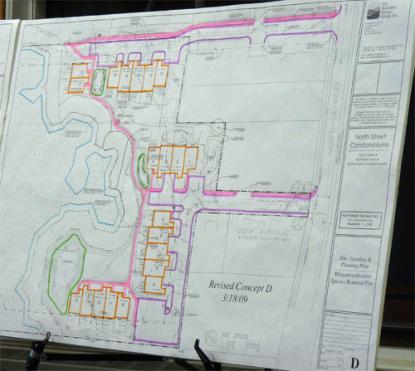
The design of the condos themselves has changed little. They show little ornamentation or variation.
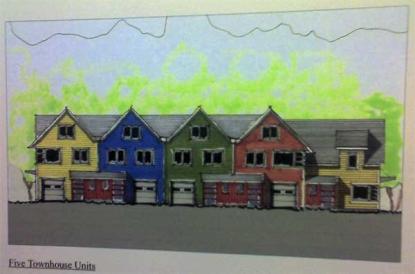
Kohl’s attorney Michael Pill claims that this project deserves deference because it’s “infill”—the homes will be within walking distance of downtown. While that’s technically correct, there’s more to Smart Growth than that.
True smart growth respects green infrastructure, according to the Urban Land Institute. This includes wetlands and woodlands. The Notre Dame School of Architecture implicitly recognizes this in their definition of "infill" in Envisioning Sustainable Northampton:
"Infill: noun – new development on land that had been previously developed, including most greyfield and brownfield sites and cleared land within urbanized area. verb- to develop such areas." (page G3)
Most of Kohl’s land is not cleared, but covered with mature trees—a rare spot of green on the US Geological Survey map of downtown Northampton.
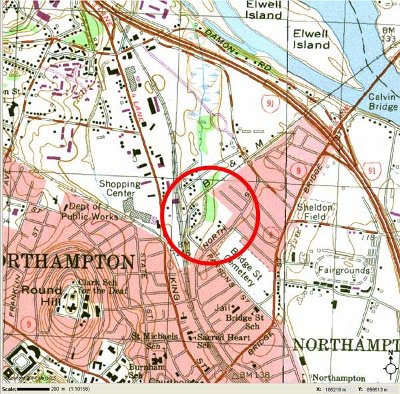
The North Street woods border a wetland, at the heart of which is Millyard Brook. Scientific studies suggest that wetlands buffers of less than 50 feet are generally ineffective at protecting wetlands, but Kohl proposes to encroach to within 35 feet. Indeed, the intensity of the proposed disturbance in the buffer zone around the wetland helped lead the Conservation Commission to deadlock on Kohl’s proposal at its March 12 hearing. (The commission reviewed a version of the proposal with the same number of units as the current one. The new version has a little less road surface and a few units are a little further away from the wetland.)
Commissioner Downey Meyer said at the March 12 hearing,
…this is the wetland that the people living in this part of the city have. It's their wetland. It might not look as beautiful as a pristine brook out in Mineral Hills that someone may have behind their house up there. But it is the wetlands that these people have…and I don't think I can say that because it's ugly now, because it has been abused, that let’s just keep on, let's keep on impacting it…
This has been the problem with this project from the beginning… When the footprint of the project impinges on the wetlands, there's no other place to do improvements… If you had the project heavily concentrated in one end of the site, going right to 35 feet, but nothing was happening down at the other end of the site, then there's some place where you can do significant mitigation in the 35 to 50 foot zone… I don't think that the difficulty is something that is set in stone. I think it's generated to a certain extent by the design of the project.
Kohl’s proposal calls for numerous large trees to be cut down. Urban trees provide valuable benefits in improved air quality, stormwater mitigation, the psychological well-being of residents, and reduction of the urban heat island effect. The loss of trees contradicts goals of the Sustainable Northampton Plan, which calls for the following:
Add standards in City’s street tree and open space programs to help reduce fossil fuel use (e.g. provide summer shade to reduce use of air conditioning) (page 22)
Minimize the loss of tree canopy throughout the City and increase tree canopy in urbanized areas to maintain a higher quality environment in all areas… Target: 2% increase in area or number per year (page 23)
In one important respect, the latest version of Kohl’s proposal is even worse than the earlier ones. The loop road around the condos has been broken into two cul-de-sacs.
Now, even though the Sustainable Northampton Plan disfavors cul-de-sacs (page 51), not all cul-de-sacs are bad. Northern Avenue is a good example of a healthy one. The reasons why include:
- It is linear
- The line of homes on the street is well integrated
- The homes are situated so you can see if mischief-makers are sneaking around your neighbors’ property (“intervisibility”)
- It is well connected to a main road (North Street)
- You can stand on North Street and see down to the end of Northern Avenue
- Access to the rear of homes on Northern Avenue is relatively restricted
- Homes line both sides of the street
Contrast this with the cul-de-sacs in Kohl's latest condo proposal:
- The roads would not be straight
- The space would be visually broken up
- The homes would be isolated from North Street
- Many units would be difficult or impossible to see from North Street
- Footpaths (shown in pink) and the woods would give easy secondary access to the units
- Homes would only be present on one side of the street
Studies find that criminals prefer small cul-de-sacs where the space is visually broken up and there is secluded access to homes. But even setting aside the security issues, this new layout reinforces the disconnection and disharmony of this project with respect to the surrounding neighborhood. It is hard to imagine that neighbors would feel comfortable walking around the dead-end access roads and paths of the development. Instead of public ways, these would feel like private spaces. This social disconnection, along with the traffic inefficiency, is why the Sustainable Northampton Plan and other Smart Growth proponents tend to oppose cul-de-sacs.
Besides preservation of green infrastructure, neighborhood integration and connectivity, another Smart Growth value is durability.
As shown in a Northampton Schools Strategic Planning document (PDF, 803KB), the Planning Department views durability as part of its Sustainable Northampton vision:
Although most of the actual policy, regulatory, and investment changes to implement Sustainable Northampton have yet to be initiated, the first changes are already underway:
- All new subdivisions now require concrete sidewalks, granite curbs, and sufficient water pressure or sprinkler systems to fight fires. These expensive features will both lower future city costs and make it far more likely that development will occur closer to downtown and Florence, where street lengths per unit are shorter, and not in outlying areas…
At a March 26 hearing, Conservation Commission member Paul Wetzel also raised the issue of durability and longevity of materials. He questioned Smith College's commitment to sustainability in light of its proposal to replace turf with a synthetic field that would need to be torn up, discarded and replaced every 15 years.
Durability is an important value in Envisioning Sustainable Northampton:
The Notre Dame School of Architecture’s guiding ideal is a built environment that is convenient, durable and beautiful; and we contend that by being convenient, durable and beautiful, the built environment will necessarily also be sustainable. (page 1)
…Durable Construction: In promoting sustainable building construction in Northampton, rewarding builders for using a limited palette of low-embodied energy building materials–e.g., integral masonry bearing walls, heavy timber frames, slate or clay tile pitched roofs; no steel reinforced concrete or steel lintels–will result in an environment of beautiful buildings that will last for hundreds of years, an essential component of a sustainable human settlement. (page 7)
Because groundwater is high on the site, Kohl proposes to use slab-on-grade foundations. The durability and longevity of these structures is a concern, not to mention their energy efficiency, another Sustainable Northampton priority.
For example, Bruce Maki, editor of HammerZone.com, has issued this “Quasi-Rant” on the matter of "Crawl Space vs. Slab Foundation":
…Quite frankly, you couldn't give me a house built on a slab foundation. With no easy access to any of the "environmental systems" (electrical, plumbing, HVAC) maintaining these structures is a nuisance at best, and a nightmare at worst…
Builders will say that slab foundations are cheaper… I don't buy into that argument. It only saves money up front, and almost certainly adds costs later, costs in maintenance and repair.
With a crawl space many maintenance and repair issues are much simpler than a slab foundation. Even more important, making changes is much easier. If the homeowner wants to build an addition, connecting to existing supply pipes, drain pipes, HVAC ducting, and wiring is much simpler. I don't know about most people, but I prefer a house that allows for some future changes. When it comes to remodeling, I can't imagine trying to work on a slab house. I can imagine charging a lot extra, though.
Another issue that nobody talks about is structural longevity. Long ago I heard a rule-of-thumb for carpentry: keep all wood at least 6 inches above the soil so the splashing water doesn't get on the house and cause decay of the wood. Around here most houses are plenty high off the ground, but many garages and sheds are built low. And I've seen many of these buildings get structural damage, typically rot but also termite infestations, from rain dripping off the roof, onto the ground, and splashing onto the building. The houses around here with basements usually have 18" to 24" of masonry directly above the soil, and no problem with rotting sill plates. Crawl spaces tend to be lower to the ground, but (from my experience) a lot higher than slab foundations. I have absolutely no confidence in the long-term structural integrity of slab-foundation houses. I have to wonder what all these fancy slab houses will be like in 30 or 40 years. I won't be doing repairs on them, that's for sure. Maybe they'll be knocked down to return the land to farming…
[Maki goes on to describe how low-slung slab buildings are more likely to have animals burrow into them, such as a squirrel that became trapped inside his slab garage and did considerable damage.]
Monster Constructors reiterates some of these concerns and adds that heat loss might also be a problem without "special precautions":
The slab-on-grade choice is very attractive to builders because of its relatively low cost. Excavation is kept to a minimum and the construction schedule can often be accelerated. The day after the slab is poured, wall framing can often begin.
But slabs come with some baggage. Frequently, plumbing drainage and water supply lines are buried beneath the slab. If something goes wrong or a leak develops, repairs can be costly. Heating or cooling ductwork buried underneath the slab can sometimes fill with water during wet seasons. Should this happen, mold can form and spores might be blasted into the home each time the air conditioner fires up. Thermal conduction issues are always present. Slabs poured in colder climates can conduct cold back into the house unless special precautions are taken. Homes built on slabs often offer little protection during tornadoes or hurricanes, unless a special masonry or concrete safe room is built within the house.
Wikipedia notes that slab foundations are less common in cold climates:
Slab-on-grade foundations are…most often seen in warmer climates, where ground freezing and thawing is less of a concern and where there is no need for heat ducting underneath the floor…
The disadvantages are the lack of access from below for utility lines, the potential for large heat losses where ground temperatures fall significantly below the interior temperature, and a very low elevation that may expose the building to flood damage in even moderate rains. Remodeling or extending such a structure may also be more difficult. Over the long term, ground settling (or subsidence) may be a problem, as a slab foundation cannot be readily jacked up to compensate…
We've previously noted how the area at the end of View Avenue, at a relatively high point on Kohl's land, reported flood damage from Tropical Storm Floyd in 1999. It's also still an open question whether some of the condos would be built on filled wetlands, which is disfavored by the 2004 Flood and Natural Hazard Mitigation Plan (PDF, 1.5MB):
Many areas of the City were developed before the passage of the Massachusetts Wetlands Protection Act of 1972. Historically filled wetlands are commonly related to problems with wet basements, flooding, shifting foundations and failed septic systems. Development in historically filled wetlands should be discouraged through zoning in order to protect health and safety. (page 24)
At the March 12 Conservation hearing, a key problem Paul Wetzel had with the condo proposal concerned the 10 units located to the right of the large detention basin. Their low elevation and proximity to groundwater bothered him. His fears are well-founded. The results of insufficient attention to water-related risks are evident at Meadowbrook Apartments. As former City Councilor Mike Kirby reported last year:
The developers built 255 units of affordable apartments there. They crammed them in everywhere they could, pushing them up into the bluffs, and close to the creek and wetlands. No backyards to speak of. One third of the buildings were built within 50 feet of the wetlands, 63% of the buildings are within the customary 100 feet of wetlands.
None of the buildings have cellars under their apartments. If they have cellars, there are people living in them. The cellar floors in the basement apartments in Buildings #4 and #2 are lower than the surrounding swamp. Some slabs have cracks in them. People have been flooded out. No moisture-proof barriers between the surrounding earth and the foundations. Moisture and mold percolate up into people's apartments via the chases that hold utilities…
In short, there is ample reason to be concerned about water intrusion damaging Kohl’s condos, reinforcing the overall concern about the durability of the proposed structures. Kohl’s own test pits found that seasonal high groundwater rises to 14-16” inches below the surface in some places (PDF report, 735KB). The neighbors have presented evidence to the Conservation Commission that the wholesale removal of large trees might induce groundwater to rise several inches further—a phenomenon called “watering-up”. A single large tree can absorb as much as 150 gallons of water from the soil each day. Trees also intercept a portion of rainfall before it reaches the ground. The years that have passed since Floyd appear to have dulled people’s concern about flooding. The latest Hazards Mitigation Plan estimates that rain-bearing tropical systems hit the Massachusetts coastline every six years on average. Since Floyd struck in 1999, the next one is overdue.
True Smart Growth, says the Urban Land Institute, preserves a community’s character, unlike development that “bears little relationship to a community’s history, culture, or geography.” ULI says homebuyers are increasingly attracted to vernacular and historical house styles that characterize their immediate area or region. Quoting Jim Constantine, a market specialist who does “curb appeal” surveys for developers, “Consumers are turned off by cookie-cutter subdivisions and the homogenous look of houses.”
Unfortunately, condo monotony–23 units that look highly similar–is exactly what Kohl Construction is offering the North Street neighborhood, which is presently characterized by a remarkable variety of sizes, styles, price points and configurations. Some houses are one-family, others more. Some are owner-occupied, others are rentals. The net result is a neighborhood that attracts people with a diverse mix of incomes, ages, jobs and living situations. The varied and distinctive personalities of each house, the lawns and gardens, the inviting streets and numerous large, handsome trees are key components of the charm of our neighborhood.
A sample of homes in the North Street neighborhood
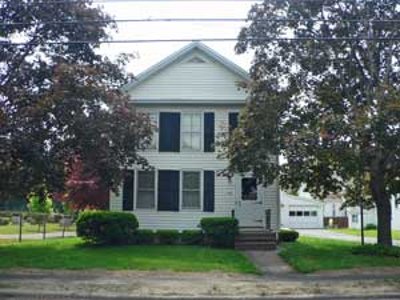
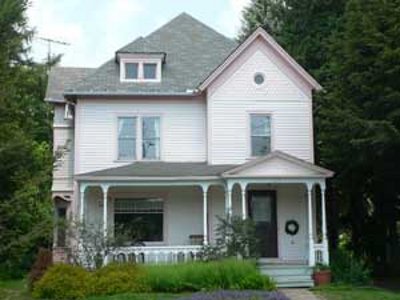
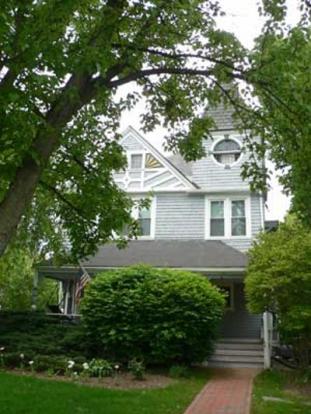
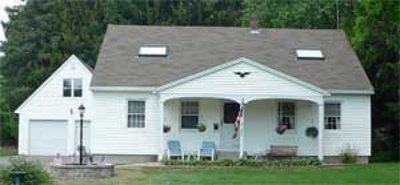
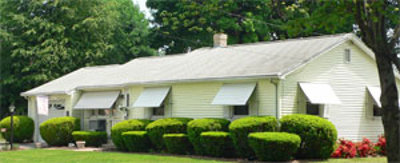
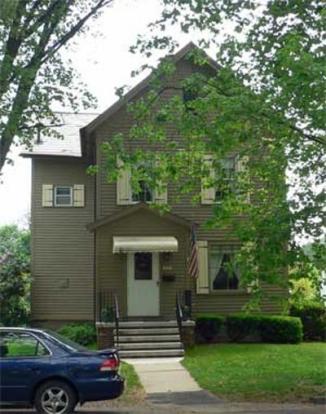
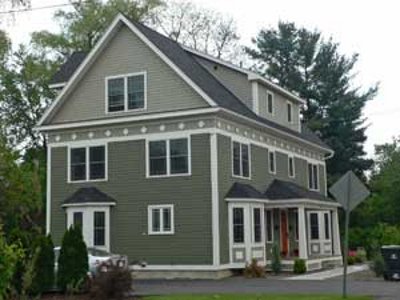
Northampton’s planning staff argues that Kohl’s designs are “very similar” to a duplex on Woodmont Road (the last picture above) and is thus in harmony with the neighborhood. This argument is unreasonable. The duplex has two units. Kohl proposes 23. Any design multiplied 23 times would not be in harmony with the neighborhood, which is characterized by the diverse appearance of its homes.
The planning staff also argues that Union Street and Graves Avenue are “within the North Street Neighborhood area”, and thus Kohl’s proposal acceptably resembles the denser land use patterns of those streets. However, the map of “Assessors Neighborhoods of the City of Northampton” (detail shown below, PDF available at the Office of Planning and Development website) classifies Kohl’s parcel in a distinctly different neighborhood (number 8) than Union and Graves (number 16). Moreover, Kohl’s parcel is in zoning district URB, whereas Union and Graves are in district URC, where higher densities are expected. There is simply no apples-to-apples comparison between Kohl’s area of North Street and Union/Graves. And dense as they are, Union and Graves are still well-integrated with the surrounding street network, unlike Kohl’s latest proposal.
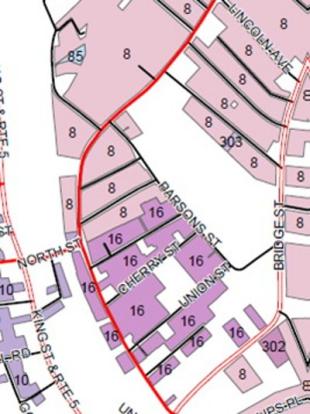
Developers must not be allowed to cherry-pick aspects of Smart Growth that suit their profit goals and ignore the rest. Former Planning Board chair Frandy Johnson has said the Sustainable Northampton Plan “has teeth”, but the only people getting bitten here are current and future residents. If Northampton wants to reduce sprawl and attract residents to its already built-up areas, it must keep these areas safe and preserve the greenspace and visual appeal that grace its traditional neighborhoods. The North Street-King Street area has plenty of cleared land, vacant parking lots and unused buildings that are better candidates for infill than our remaining groves of trees.
And one more thing…
One aspect of the Kohl condo controversy actually has more to do with best practices than Smart Growth. At the January Planning Board hearing, Kohl implied the neighbors were obstinate and rigid for not negotiating with him over the design of the project. The neighbors feel hamstrung in this regard, however, because a Land Court lawsuit over titles and rights-of-way on the property is not resolved. We don’t know what the baseline is that we should start negotiating from.
Even Michael Pill, I believe, would concede at this point that the lawsuit is not frivolous, and indeed the judge has agreed to hear our motion for summary judgment this coming August. The neighbors have asked the Planning Board to defer consideration of Kohl’s proposal until the case is resolved. The board decided to proceed anyway. There is a strong possibility that even if the Conservation Commission and Planning Board approve Kohl’s proposal in the coming months, they will have to revisit it all over again after decisions come down from Land Court. None of this strikes me as good practice or an efficient use of people’s time.
Adam Cohen is a resident of North Street and a member of the North Street Neighborhood Association. For more analysis of Smart Growth and Kohl’s proposals, see the website of the North Street Neighborhood Association, www.northassoc.org.


